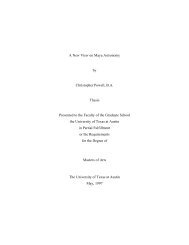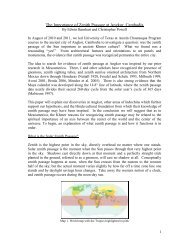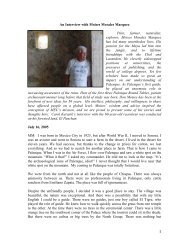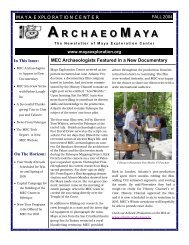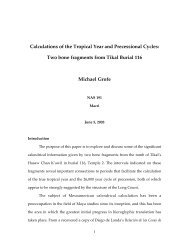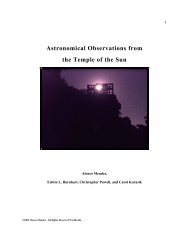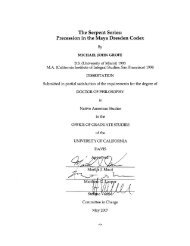Mesas de Brujo of Northern Coastal Peru - Maya Exploration Center
Mesas de Brujo of Northern Coastal Peru - Maya Exploration Center
Mesas de Brujo of Northern Coastal Peru - Maya Exploration Center
You also want an ePaper? Increase the reach of your titles
YUMPU automatically turns print PDFs into web optimized ePapers that Google loves.
<strong>Mesas</strong> <strong>de</strong> <strong>Brujo</strong> <strong>of</strong> <strong>Northern</strong> <strong>Coastal</strong> <strong>Peru</strong>;Mo<strong>de</strong>rn Forms, Ancient Prece<strong>de</strong>ntsEd BarnhartFall 1994
3<strong>Brujo</strong>, however, has been more difficult to tie back to ancient customs. This paper willattempt to establish a relationship between the mo<strong>de</strong>rn <strong>Mesas</strong> <strong>of</strong> the once MocheValleys and the more permanent structures <strong>de</strong>picted in ancient Moche art. Connectionsbetween the participants, associated paraphernalia, and methods <strong>of</strong> protection will bedrawn on to support the argument. First, the nature <strong>of</strong> the mo<strong>de</strong>rn rituals will bediscussed, followed by a comparison to the images <strong>of</strong> shamanistic ritual in the ancientart. Finally, an explanation for the creation <strong>of</strong> the Mesa will be <strong>of</strong>fered.The Ritual <strong>of</strong> the Mesa <strong>de</strong> <strong>Brujo</strong>The information used here to <strong>de</strong>scribe the ritual <strong>of</strong> the Mesa <strong>de</strong> <strong>Brujo</strong> comes fromthree separate reports from individuals who studied Curan<strong>de</strong>rismo <strong>of</strong> northern coastal<strong>Peru</strong>; John Gillin in 1947, Marlene Dobkin <strong>de</strong> Rios in 1967 and Douglas Sharon in 1978.Gillin's discussion <strong>of</strong> Curan<strong>de</strong>rismo and <strong>Mesas</strong> is part <strong>of</strong> a larger study <strong>of</strong> the coastalcommunity in the town <strong>of</strong> Moche. He does not reveal the name <strong>of</strong> his informant butsays the man was about sixty years old and received his training from the great mastersin the town <strong>of</strong> Salas when he was a young man. Gillin's informant had gone to Salas tobe cured <strong>of</strong> an infection on his leg and, because he had no money, worked his <strong>de</strong>bt <strong>of</strong>fby serving as an assistant to the master who cured him. The master <strong>de</strong>ci<strong>de</strong>d he hadthe gift and kept him on to be fully trained as a Curan<strong>de</strong>ro (1947;118). Gillin wasallowed to participate in night healing sessions. His informant also agreed to set theMesa up in daylight so it could be photographed (Figure 2). Gillin's study was the first to<strong>de</strong>scribe the rituals <strong>of</strong> the Mesa in more than a passing reference.In the summer <strong>of</strong> 1967, Dobkin <strong>de</strong> Rios interviewed the people <strong>of</strong> a coastalvalley village about folk healing practices. She also witnessed a number <strong>of</strong> <strong>Mesas</strong>essions. The focus <strong>of</strong> her study was to <strong>de</strong>fine the use <strong>of</strong> hallucinogens in healing
4rituals and it connection to the larger concept <strong>of</strong> shamanism. She i<strong>de</strong>ntified San PedroCactus (Trichocereus pachanoi) and Misha (Datura arborea) as hallucinogenic plantscommonly used in the rituals <strong>of</strong> the Mesa <strong>de</strong> <strong>Brujo</strong>. A number <strong>of</strong> other less commonlyused plants were also i<strong>de</strong>ntified. In the years after her field study, Dobkin <strong>de</strong> Rios wrotea number <strong>of</strong> articles comparing her research on mo<strong>de</strong>rn healing practices to the images<strong>of</strong> shamanism found in the art <strong>of</strong> the ancient Moche (1977,1982). Her conclusions areintriguing and will be drawn on heavily in this paper.The work <strong>of</strong> Douglas Sharon, who became an apprentice to a master in the town<strong>of</strong> Trujillo, is the most complete study <strong>of</strong> northern coastal Curan<strong>de</strong>rismo written to date.Sharon's informant and master was named Edwardo Cal<strong>de</strong>ron (Figure 3). The two metin July <strong>of</strong> 1965 on the Chan-Chan project. Cal<strong>de</strong>ron was one <strong>of</strong> the artists helping toreconstruct the building faca<strong>de</strong>s. Sharon and Cal<strong>de</strong>ron became good friends and theyhad many in <strong>de</strong>pth conversions about the role <strong>of</strong> the healer and the power <strong>of</strong> the Mesa.In 1951, when Cal<strong>de</strong>ron was twenty one, he was cured <strong>of</strong> a serious illness by acuran<strong>de</strong>ro. He had been a jack-<strong>of</strong>-all-tra<strong>de</strong>s most <strong>of</strong> his life and <strong>de</strong>ci<strong>de</strong>d after thisexperience to try folk healing. Both <strong>of</strong> his grandfathers had been curan<strong>de</strong>ros and many<strong>of</strong> his other relatives had followed that tradition. The power to heal was strong in hisfamily. He first became an apprentice to a relative but later moved north to the towns <strong>of</strong>Chiclayo, Mocupe and Ferrenafe to learn from the famous masters known to live there.His training took a total <strong>of</strong> seven years (Sharon 1978;13-15). Cal<strong>de</strong>ron's <strong>de</strong>ep familyroots in healing combined with travels and intelligence make his testimony a veryilluminating source. Sharon's book, Wizard <strong>of</strong> the Four Winds, covers a number <strong>of</strong>topics related to the rituals <strong>of</strong> the Mesa and much <strong>of</strong> the book is English translations <strong>of</strong>Cal<strong>de</strong>ron's own words. That book, as well as the works <strong>of</strong> Gillin and Dobkin <strong>de</strong> Rios,have been utilized to create the following <strong>de</strong>scription <strong>of</strong> the Mesa ceremony.
5The ultimate goal <strong>of</strong> the ceremony is to divine the cause <strong>of</strong> illness. The cause isalways a spirit or evil brujo psychicly attacking the patient. Often times the perpetratoris divined to be a member <strong>of</strong> the family or community who has hired an evil brujo tobewitch them. In the coastal valleys <strong>of</strong> northern <strong>Peru</strong>, as in many areas <strong>of</strong> the NewWorld, brujos, or shamans, are separated into good and evil. Cal<strong>de</strong>ron calls goodshamans curan<strong>de</strong>ros and evil shamans brujos. To Gillin, they were simply good andbad brujos. Though no scholar has been allowed to study it in <strong>de</strong>pth, all agree that evilbrujeria uses the same techniques as curan<strong>de</strong>rismo. Gillin reported that they also havea Mesa, with a black cloth, which they use to control evil spirits called shapingos.These spirits are sent out to cause illness and to disrupt the ceremonies <strong>of</strong> healers.They are also said to be sent out to have sex with women. If the women submit theyare then servants to the evil brujo. If they resist, they fall ill (1947: 128). As a final noteon evil brujeria, Gillin reported that evil brujos have the power to transform into birdsand animals, a power closely linked to the concept <strong>of</strong> shamanism. In a later section <strong>of</strong>this paper, animal transformation as seen in Moche art will be discussed.Returning to the ceremony <strong>of</strong> the good Mesa <strong>de</strong> <strong>Brujo</strong>, we see its purpose to bethe repelling <strong>of</strong> evil shapingos and the i<strong>de</strong>ntification <strong>of</strong> the evil brujo responsible for theirattack. This information is given to the master by his spirit companions who allow himto "see" the attacker. The spirits are called to the ceremony by the chants and whistlesperformed by the master. The master has different chants and whistles to call differentspirits. The objects on the Mesa become the portals through which they make contact.The vehicle that allows the master and others present to communicate with the spirits isthe ingestion <strong>of</strong> hallucinogens through imbibing <strong>of</strong> a brew <strong>of</strong> San Pedro, sometimesmixed with Misha. Cal<strong>de</strong>ron preferred not to use Mishas in his ceremonies while Gillin'sinformant chewed Misha throughout his version <strong>of</strong> the ceremony. All ceremonies
6appear to involve the drinking and snuffing <strong>of</strong> liquids.The ceremony always takes place at night, beginning at 9 or 10pm. Theparticipants typically inclu<strong>de</strong> the master, one or two assistants called "alzadores" orraisers, the patient, and any family members or friends who wish to attend. The firstsection <strong>of</strong> the ceremony lasts until midnight and is meant to activate the Mesa or openthe portal. Cal<strong>de</strong>ron refers to it as "opening the account". It is opened by chants,whistling and the "raising" <strong>of</strong> the table and the participants. Raising is done by snuffingliquid from a flat shell, first kneeling, then on one knee and so own until the person isstanding straight up. This process is done by the assistants around the master and thepatient. The master and sometimes the patient also snuff liquid from shells during theceremony. The liquid varies from ceremony to ceremony and can contain combinations<strong>of</strong> perfumes, tobacco, hallucinogens and water. During this first phase <strong>of</strong> the ceremonyshapingos may attack to disrupt the ceremony and must be repelled by chants and theflashing <strong>of</strong> swords or knives in the air. The impression is that the spirits are visible,physical beings attacking.At midnight, the healing session beings. All participants are asked to drink theSan Pedro brew at this time. An interesting connection to report here is the fact that theflower <strong>of</strong> the San Pedro Cactus blooms at midnight. The master goes into a tranceduring which he makes contact with his spirit companions and learns the i<strong>de</strong>ntity <strong>of</strong> theattackers. The ceremony ends around sunrise, typically 6am, and soon after the masterreveals the i<strong>de</strong>ntity <strong>of</strong> the attacker to the patient and gives them some herbs to beingested after returning home.The Objects <strong>of</strong> the MesaThe Mesa itself is a white piece <strong>of</strong> cloth, approximately one meter square, upon
7which a number <strong>of</strong> objects are placed. The objects are a collection <strong>of</strong> power objects.The objects are artifacts from ancient ruins, pictures <strong>of</strong> saints, staffs, swords, knives,stones, shells and many bottles containing liquids and herbs. Depending on the nature<strong>of</strong> the illness the patient faces, the master calls on the power <strong>of</strong> different objects on theMesa through his chants and whistles. They aid him to evoke spirits and enter theotherworld. A large container <strong>of</strong> San Pedro brew, boiled for seven hours before theceremony, sits near by. At the head <strong>of</strong> the Mesa stand knives, swords and staffs,meant to protect the ceremony from evil shapingos and also to act as power objects tocall protector spirits through.Edwardo Cal<strong>de</strong>ron explained the metaphysical level <strong>of</strong> his Mesa at some length(Sharon 1978;70). He sees his Mesa as a microcosm <strong>of</strong> the world and a symbolbalance between good and evil (Figure 4). The Mesa is divi<strong>de</strong>d into four sections by across connecting to the four corners. Cal<strong>de</strong>ron connects the cross to the four roadsleading to the Four Winds. A christian cross sits at the center, symbolizing the AxisMundi. On another level, the Mesa is divi<strong>de</strong>d into three sections; the "CampoGana<strong>de</strong>ro, Campo Medio, and Campo Justiciero". These three sections representgood, evil and the middle ground between the two. Gillin's informant does not discusshis Mesa at this level but the photos taken by Gillin suggest that it was also divi<strong>de</strong>d intothree "campos", meant to represent a balance between the powers <strong>of</strong> good and evil(Figure 5).The most numerous objects on the Mesa are the bottles. They contain herbsand liquids combined to snuff from the shells during the ceremony in the "raising" ritual.They also contain white corn meal and perfumes to be sprayed from the mouth <strong>of</strong> themaster at moments in the ceremony. The San Pedro brew is kept in a container nearthe Mesa as well. Some <strong>of</strong> the objects on the Mesa are rarely used but the contents <strong>of</strong>
9Sharon and Cal<strong>de</strong>ron met a master named Don Florentino in the area and wereallowed to participate in his ceremonies. Don Florentino conducted sessions involvingmany patients at once, sometimes as many as twenty (Sharon 1978;129). When themen arrived at the house <strong>of</strong> the master a number <strong>of</strong> people were waiting in his frontyard, having ma<strong>de</strong> the pilgrimage from their homes to be cured or blessed. One <strong>of</strong> thepatients was a young boy who had gone insane. He ran around the group acting wildand unpredictable. Don Florentino arrived in the afternoon and lead the group up to thelagoons, through a marshy bog. The participants dipped their personal charms in thewaters <strong>of</strong> the lagoon while the master chanted and sprayed mixtures <strong>of</strong> perfume andwhite corn meal from his mouth. The process was meant to bring good luck an<strong>de</strong>mpower the charms. The group then returned to Don Florentino's home for a nightsession with the Mesa (Sharon 197n the introduction <strong>of</strong> this paper, shamanism comes in a number <strong>of</strong> different forms in theNew World. A culture's form <strong>of</strong> shamanism is a <strong>de</strong>eply rooted part <strong>of</strong> their ethnicity andhelps them to <strong>de</strong>fine themselves as a people. One <strong>of</strong> the primary factors that are usedto differentiate between forms <strong>of</strong> shamanism is the method chosen to inducehallucinations. A wi<strong>de</strong> variety <strong>of</strong> methods exist and are partially a product <strong>of</strong> the flora intheir places <strong>of</strong> origin. In the mo<strong>de</strong>rn northern coastal valleys <strong>of</strong> <strong>Peru</strong>, San Pedro andMisha are the hallucinogenic plants used by curan<strong>de</strong>ros and brujos to visit the spiritworld. Both <strong>of</strong> those plants have been i<strong>de</strong>ntified in the art <strong>of</strong> the ancient Moche (Dobkin<strong>de</strong> Rios 1977;191) and show up in a number <strong>of</strong> different contexts, all <strong>of</strong> which can belinked to shamanism (Figure 6). Figure 7 displays a famous Moche vessel that has longbeen interpreted as a healer treating a patient. The healer has transformed into an owland holds a piece <strong>of</strong> San Pedro in her hand. At her left is a figure lying in a bed with theface <strong>of</strong> a being Benson terms the "Fanged Deity" (Figure 8). Shamans in Moche art are
10<strong>of</strong>ten shown impersonating or transforming into this being. At her right lies an open boxwith multiple small objects insi<strong>de</strong> it (Figure 9). She looks down into an open mouthedvessel appearing to be placing the San Pedro into it. In front <strong>of</strong> that vessel a number <strong>of</strong>odd objects are painted in as if they were lying on the ground in front <strong>of</strong> the healer.Below the healer, painted around the si<strong>de</strong>s <strong>of</strong> the vessel, is another individual, seated ina prayer position, sitting in front <strong>of</strong> a table holding four jars. The jars have plant twigsextending <strong>of</strong>f their si<strong>de</strong>s. A llama is tied up just beyond the table (Figure 10). Thecombination <strong>of</strong> elements in this particular piece <strong>of</strong> Moche art speaks strongly in favor <strong>of</strong>continuity in the form <strong>of</strong> healing rituals between ancient and mo<strong>de</strong>rn times. The imageclearly links the treatment <strong>of</strong> patients with the use <strong>of</strong> San Pedro and displays variousother objects involved in the ritual. The objects displayed may be related to the objectsfound on the mo<strong>de</strong>rn <strong>Mesas</strong>. In another frequently cited image from the si<strong>de</strong> <strong>of</strong> a stirruphandled vessel, a man looks up towards an arc in the sky (Figure 11). His hands areheld together above him and his mouth is open as if he is making some sort <strong>of</strong>utterance, likely chanting or singing. In the background float images <strong>of</strong> uprooted SanPedro and Misha. Three seated figures in the scene watch the actions <strong>of</strong> the chantingfigure, reminiscent <strong>of</strong> the participants in mo<strong>de</strong>rn Mesa ceremonies. The entire scene iscovered in black dots floating above the heads <strong>of</strong> the people. They may represent thestars (with the arc as the Milky Way) or visual impairment caused by hallucinations.Images <strong>of</strong> San Pedro cactus, Misha and other hallucinogenic plants are als<strong>of</strong>ound in association with a common theme in Moche vessel painting. The themeinvolves a procession <strong>of</strong> individuals running through varying landscapes, thoughcommonly in an upward direction. The members <strong>of</strong> the procession wear ritualheaddresses and carry what appear to be small bags. These images have beeninterpreted as <strong>de</strong>pictions <strong>of</strong> runners who relayed messages along the roadway to distant
11parts <strong>of</strong> the Inca empire with great speed. Many <strong>of</strong> the paintings displaying this theme,however, show various hallucinogenic plants floating in the background, clearlyconnecting the scene to visions and communication with the spirit world (Figure 12).Dobkin <strong>de</strong> Rios suggested that the runner theme actually represents shamans in theprocess <strong>of</strong> transformation (1977;200). The evi<strong>de</strong>nce supports her hypothesis. Somescenes portray the runners as human (Figures 12 and 13) and other asanthropomorphized animals (Figure 14). Yet others show a combination <strong>of</strong> the two(Figures 15 and 16). Building on the Dobkin <strong>de</strong> Rios i<strong>de</strong>ntification <strong>of</strong> animaltransformation in the runners theme, a new theory is put forth here. The runner scenesmay <strong>de</strong>pict shamans on a sacred pilgrimage to collect herbs and hallucinogenic plantsin the bags they carry. As with mo<strong>de</strong>rn curan<strong>de</strong>ros, the <strong>de</strong>stinations <strong>of</strong> pilgrimagesappear to have been mountain locations. Cal<strong>de</strong>ron explained the pilgrimage to LasHuaringas as a spiritual metamorphosis (Sharon 1978;134), a process clearly takingplace in the ancient "runner" images. This paper suggests a more appropriate name forthe theme would be pilgrimage scene.Possibly the single most important essential part <strong>of</strong> the mo<strong>de</strong>rn Mesa ceremonyis the drinking <strong>of</strong> the San Pedro brew. Cups being passed and drank from are commonin ancient images interpreted as being portrayals <strong>of</strong> ritual. Dobkin <strong>de</strong> Rios notes theuse <strong>of</strong> cups and suggests a connection to the mo<strong>de</strong>rn San Pedro drinking (1977;195).A mural uncovered during excavations at Panamarca shows individuals in shamanicdress presenting cups (Figure 17). One individual is larger than the others and ispresumably the master <strong>of</strong> the ceremony. The others appear to be assistants and eithercaptives or patients. Dobkin <strong>de</strong> Rios has suggested that <strong>de</strong>pictions nu<strong>de</strong> individualswith ropes around their necks are insane people in need <strong>of</strong> healing, not captives as theyare commonly interpreted (1977;197). The logic behind her theory will be discussed in
12more <strong>de</strong>tail later. Next, a theme in Moche art Christopher Donnan calls thePresentation Ceremony will be discussed.In his 1976 book Moche Art and Iconography, Chrisopher Donnan i<strong>de</strong>ntified atheme in Moche art he named the Presentation Ceremony. Using a particularlyelaborate <strong>de</strong>piction <strong>of</strong> the ceremony (Figure 18), Donnan separates major actors an<strong>de</strong>lements in the scene alphabetically in <strong>de</strong>scending or<strong>de</strong>r by importance to theceremony. Donnan suggests the ceremony involves the sacrifice <strong>of</strong> prisoners andi<strong>de</strong>ntifies the contents <strong>of</strong> the cups being presented to Figure A as human blood. In aseries <strong>of</strong> exciting excavations at the sites <strong>of</strong> Sipan and Huaca <strong>de</strong>l <strong>Brujo</strong> in the late1980's, tombs <strong>of</strong> Moche individuals wearing costumes similar to those worn byDonnan's Figures A, B and C were discovered. In the image, Figure D is separatedfrom the activities <strong>of</strong> Figures A, B and C. Figure D holds no cup, appears to be singingor chanting and wears the jaguar headdress typically worn by shamans in Moche art.He is also the largest <strong>of</strong> the individuals represented in the scene. The importance <strong>of</strong>chanting to the calling out <strong>of</strong> spirits in mo<strong>de</strong>rn Mesa ceremonies has already beendiscussed in a previous section <strong>of</strong> this paper. Figure D has a smaller figure floating justbehind him which Donnan explains as personified a spear and shield. Upon closeranalysis, however, it is actually a fully human figure about to drink from a cup. It is thehypothesis <strong>of</strong> this paper that Figure D is a shaman and the floating figure behind FigureD is a spirit being called out by his chanting. The cups being passed around likelycontain not blood but rather San Pedro brew. Other images also show combination <strong>of</strong>the passing <strong>of</strong> cups and floating spirits (Figures 19 and 20).Another common scene in Moche art <strong>de</strong>picts individuals approaching structuresin which shamanic figures sit (Figure 21). The structures typically have spearsprotruding from the ro<strong>of</strong> (Figures 21,22 and 23). Within the structure, the shaman sits
13with either vessels or jars around him (Figures 21 and 22) or holding a cup (Figure 23).In yet others, the shaman is shown chanting within the structure (Figure 24). Dobkin <strong>de</strong>Rios i<strong>de</strong>ntifies these structures as temporary structures called tambos. She reportshaving witnessed the construction <strong>of</strong> these temporary structures to conduct "drugsessions" un<strong>de</strong>r them (1977;197).The scene in Figure 23 shows a procession <strong>of</strong> nu<strong>de</strong> figures, some carried in kthe image to the ancient Moche shamanic complex. It is important to note that the nu<strong>de</strong>figures prece<strong>de</strong> the warriors that hold the end <strong>of</strong> their ropes. A typical prisoner imageshows captives being lead, not followed. Dobkin <strong>de</strong> Rios interprets the haircuts and<strong>de</strong>ranged expressions <strong>of</strong> the nu<strong>de</strong> figures as marking them as insane (1977;197).An element <strong>of</strong> the mo<strong>de</strong>rn Mesa that was noted in all examples discussed in thispaper is the presence <strong>of</strong> swords, knives and staffs standing up in front <strong>of</strong> it. Cal<strong>de</strong>ronexplained these weapons as both <strong>de</strong>fenses against shapingos and antenna to attractspirit companions. Sharon draws a comparison between the figures carved into thetops <strong>of</strong> Cal<strong>de</strong>ron's staffs and staffs found in excavations <strong>of</strong> Moche ruins (1978;63). Thispaper suggests that there is a connection between the staffs and swords <strong>of</strong> the mo<strong>de</strong>rn<strong>Mesas</strong> and the staffs that protru<strong>de</strong> <strong>of</strong>f <strong>of</strong> the structures Dobkin <strong>de</strong> Rios terms tambos inthe ancient art (Figures 21, 22 and 23). A beautiful staff recently excavated at theMoche ceremonial center <strong>of</strong> Sipan lends further support to this hypothesis (Figure 26).Atop the staff sits the image <strong>of</strong> a tambo completely surroun<strong>de</strong>d by upright staffs. Withinthe tambo, an image <strong>of</strong> the Fanged Deity has sex with a woman. Donnan, Benson andDobkin <strong>de</strong> Rios all agree that erotic images in Moche art are <strong>of</strong> a magico-religiousnature. It is the interpretation <strong>of</strong> your author that the staffs in Figure 26 are serving thesame purpose as the staffs <strong>of</strong> the mo<strong>de</strong>rn Mesa, antennae to channel the spirits.Further, even scenes <strong>of</strong> shamanic content without structures <strong>of</strong>ten inclu<strong>de</strong> an upright
14staff as part <strong>of</strong> the image (Figures 11,17,18 and 19).The image <strong>of</strong> the Fanged Deity having sex with a woman is another repeatedscene in Moche art. In Figure 27, three very similar scenes involving this motif arecompared. The center image appears to be the Fanged Deity but the upper and lowerimages feature mortal men. Many elements <strong>of</strong> Moche shamanism discussed in thispaper are present in these images. The scene is also reminiscent <strong>of</strong> Gillin's <strong>de</strong>scription<strong>of</strong> the powers <strong>of</strong> evil brujos in the village <strong>of</strong> Moche. He reported that evil brujos sentshapingos to have sex with women and <strong>of</strong>ten transformed into birds (1947;128). It ispossible that the scenes <strong>of</strong> Figure 27 are showing evil spirits attacking a female patientand the healer is an anthropomorphized bird dowsing the couple with liquid from a jar.The final element <strong>of</strong> the Mesa ceremony that will be discussed here are the seashells. Again, all accounts <strong>of</strong> Mesa ceremonies report the use <strong>of</strong> shells to snuff liquidthrough the nose during the "raising" ritual. Conch shells are part <strong>of</strong> the ancient Mocheshamanic complex, clearly <strong>de</strong>monstrated in the images (Figure 21), but appear to havebeen used to whistle through. The shells used for snuffing are flat shells and are rare inMoche art. In the recent Sipan excavations, however, elite individuals were foundinterred with many flat spondylous shells, among other objects (Figure 28).ConclusionThis paper has attempted to <strong>de</strong>monstrate that many <strong>of</strong> the elements <strong>of</strong> themo<strong>de</strong>rn Mesa <strong>de</strong> <strong>Brujo</strong> ceremony are present in ancient Moche art <strong>de</strong>picting shamanicactivities. The Mesa itself, however, is absent from the ancient imagery. This paperproposes that the Mesa was <strong>de</strong>veloped at the time <strong>of</strong> conquest in response to Spanishcolonial attempts to wipe out "witch craft" in <strong>Peru</strong>. Curan<strong>de</strong>rismo and brujeria alikehave been against the law since the time <strong>of</strong> conquest and have had to adapt to this
15persecution in or<strong>de</strong>r to survive.In 1638, in his Cronica Moralizada, Father Antonio <strong>de</strong> la Calancha makesmention <strong>of</strong> a <strong>de</strong>tention camps for shamans who were being punished for idolatry.Calancha's report was from another priest who wrote <strong>of</strong> a shaman who said he hadvisited the <strong>de</strong>tention camp during trance from over two miles away (1638:631-33).Sharon cites a legal case against a curer in 1782 accused <strong>of</strong> curing with a brew.The curer escaped but his amulets and talismans were found and confiscated. Sharonsuggests the objects were similar to those found on the mo<strong>de</strong>rn Mesa (1978;43).As a final example, in 1947 a group <strong>of</strong> informants from the village <strong>of</strong> Mocherelated to Gillin a story <strong>of</strong> a Mesa ceremony that was rai<strong>de</strong>d by the police. The wife <strong>of</strong>an influential man in time fell very ill and a Mesa ceremony was done to heal her. Theceremony took place in a seclu<strong>de</strong>d part <strong>of</strong> the campo and the patient was carried there.On the second night, the ceremony was rai<strong>de</strong>d by the police. As luck would have it, thehusband was friends with the police chief and was able to bribe him to allow theceremony to continue. The wife was cured during that second night and, in a third nightsession, the curan<strong>de</strong>ro told her the i<strong>de</strong>ntity <strong>of</strong> the attacker; a jealous niece (1947;123).Many <strong>of</strong> the elements <strong>of</strong> the Mesa ceremony are present in the ancient art; thehallucinogens used, the pilgrimages to collect them, the drinking <strong>of</strong> San Pedro, thehealing <strong>of</strong> patients, the chanting, the shells, the assistants, the onlooking participantsand the staffs and swords to protect the ceremonies. The Mesa in the northern coastalvalleys <strong>of</strong> <strong>Peru</strong> was created as a mobile setting used to created sacred space for a folkhealing tradition practiced since ancient Moche times. What once was practiced inpermanent, public structures was forced into hiding by the conquest. Healers nee<strong>de</strong>d aspace that could be easily moved to avoid authorities, hence the birth <strong>of</strong> the Mesa <strong>de</strong><strong>Brujo</strong>.
16BibliographyAlva, Walter and Chrisopher B. Donnan1993 Royal Tombs <strong>of</strong> Sipan. Fowler Museum <strong>of</strong> CulturalHistory, University <strong>of</strong> California, L.A.Benson, Elizabeth P.1972 The Mochica - A Culture <strong>of</strong> <strong>Peru</strong>. PraegerPublishers, New York, Washington.1974 A Man And A Feline In Mochica Art. DumbartonOaks Trustees for Harvard University,Washington, D.C.Calancha, Antonio <strong>de</strong> la1638 Cronica Moralizada <strong>de</strong>l Or<strong>de</strong>n <strong>de</strong> San Agustin en el <strong>Peru</strong>,con Sucesos Ejemplares <strong>de</strong> Esta Monarquia. Barcelona:Pedro Lacavalleria.Dobkin <strong>de</strong> Rios, Marlene1977 "Plant Hallucinogens and the Religion <strong>of</strong> the Mochica - AnAncient <strong>Peru</strong>vian People". Economic Botany, vol. 31, 189-203, April-June 1977.1982 "Plant Hallucinogens, Sexuality and Shamanism in the CeramicArt <strong>of</strong> Ancient <strong>Peru</strong>". Journal <strong>of</strong> Psychoactive Drugs, vol. 14,81-90, Jan-Jun 1982.Donnan, Chrisopher B.1976 Moche Art and Iconography. UCLA Latin American<strong>Center</strong> Publications. University <strong>of</strong> California,Los Angeles.1978 Moche Art - La Costa Norte <strong>de</strong>l <strong>Peru</strong>". Ibero-Amerikan-IschesArchiv, N.F. 13: 117-128, Berlin.Sharon, Douglas1978 Wizard <strong>of</strong> the Four Winds. The Free Press, A Division <strong>of</strong>Macmillan Publishing Co., Inc., New York.
17List <strong>of</strong> FiguresFigure 1. Mesa <strong>de</strong> <strong>Brujo</strong> (from Sharon 1978)Figure 2. Mesa <strong>de</strong> <strong>Brujo</strong> <strong>of</strong> Gillin's informant (from Gillin 1947)Figure 3. Edwardo Cal<strong>de</strong>ron at his Mesa (from Sharon 1978)Figure 4. Divisions <strong>of</strong> Cal<strong>de</strong>ron's Mesa (from Sharon 1978)Figure 5. Diagram <strong>of</strong> Mesa objects from Gillin (1947)Figure 6. Depictions <strong>of</strong> San Pedro and Misha (from Dobkin <strong>de</strong> Rios 1977)Figure 7. Shaman healer (from Donnan 1978)Figure 8. Patient with the face <strong>of</strong> the Fanged Deity (from Donnan 1978)Figure 9. Box <strong>of</strong> Objects (from Donnan 1978)Figure 10. Image on the lower register <strong>of</strong> the healer vessel (from Hocquenghem 1987)Figure 11. Shamanic ceremony (from Kutscher 1983)Figure 12. Pilgrimage (from Kutscher 1983)Figure 13. Pilgrimage to gather Misha (from Kutscher 1983)Figure 14. Pilgrimage (from Kutscher 1983)Figure 15. Pilgrimage (from Kutscher 1987)Figure 16. Pilgrimage (from Hocquenghem 1987)Figure 17. Cup presentation scene (from Donnan 1978)Figure 18. Donnan's Presentation Ceremony (from Kutscher 1983)Figure 19. Cup presentation and floating spirits (from Alva and Donnan 1993)Figure 20. Cup presentation and floating spirits (from Kutscher 1983)Figure 21. Shaman insi<strong>de</strong> a structure (from Kutscher 1983)Figure 22. Shaman insi<strong>de</strong> a structure (from Kutscher 1983)Figure 23. Procession <strong>of</strong> patients being carried to a shaman (from Kutscher 1983)Figure 24. Chanting shaman insi<strong>de</strong> a structure (from Hocquenghem 1987)Figure 25. Roped, naked figures (from Dobkin <strong>de</strong> Rios 1977)Figure 26. Structure surroun<strong>de</strong>d by spears (from Alva and Donnan 1993)Figure 27. Shamanic copulation scene (Donnan 1978)Figure 28. Tomb Two at Sipan (Alva and Donnan 1993)
Figure 1. Mesa <strong>de</strong> <strong>Brujo</strong> (from Sharon 1978)
Figure 3. Edwardo Cal<strong>de</strong>ron at his Mesa (from Sharon 1978)
Figure 5. Diagram <strong>of</strong> Mesa objects from Giliin (1947)
Figure 7. Shaman healer (from Donnan 1978)
Figure 9. Box <strong>of</strong> Objects (from Donnan 1978)Figure 8. Patient with the face <strong>of</strong> the Fanged Deity (from Donnan 1978)Figure 10. Image on the lower register <strong>of</strong> the healer vessel (from Hocquenghem 1987)
Figure 13. Pilgrimage to gather Misha (from Kutscher 1983)
Figure 21. Shaman insi<strong>de</strong> a structure (from Kutscher 1983)Figure 22. Shaman insi<strong>de</strong> a structure (from Kutscher 1983)
-Figure 25. Roped, naked figures (from Dobkin <strong>de</strong> Rios 1977)
Figure 26. Structure surroun<strong>de</strong>d by spears (from Alva and Donnan 1993)
Figure 28. Tomb Two at Sipan(Alva and Donnan 1993)



